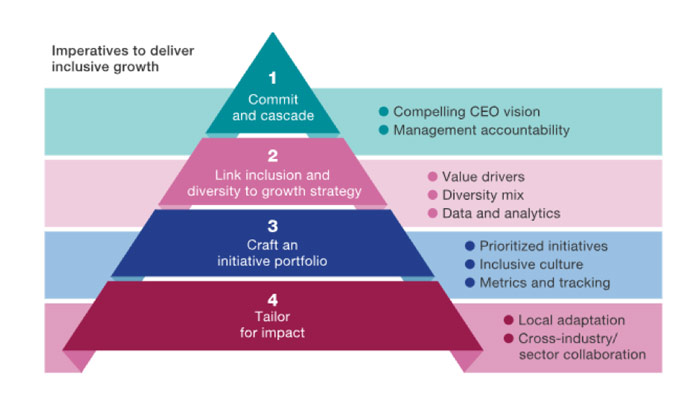
‘Diversity’ is still an empty word in much of corporate America. You only need to look at some recent headlines to figure out that too many businesses, including global brands and their agencies, just don’t get it.
Last year, Pepsi came under fire for a commercial featuring Kendall Jenner and imagery from the Black Lives Matter movement. Dove faced criticism for an ad that depicted a black woman transforming into a white woman. And Heineken withdrew an ad featuring the slogan “Sometimes, lighter is better.”
And it’s not just in the public domain that companies are failing at diversity. In 2016, women held just 4.2% of CEO positions in America’s 500 biggest companies, African Americans were 16% less likely to get invited to job interviews, and white names got 50% more callbacks than black names, regardless of the industry or occupation.
Progress has been embarrassingly slow, with industries like tech and finance lacking diversity at all levels.
And yet the benefits are so clear…
Diversity and Inclusion Strategy: A Case for Diversity
Every year, research giant McKinsey & Co releases a report on workplace diversity. And every year it finds a strong correlation between diversity and financial performance. According to them, it’s clear that companies with greater gender and racial diversity financially outperform their peers.
In particular, McKinsey has found that having gender diversity on executive teams leads to higher profitability, and that executive teams of outperforming companies have more women in line roles versus staff roles. They also found that companies with the most ethnically diverse executive teams—not only with respect to absolute representation but also of variety or mix of ethnicities —are 33% more likely to outperform their peers on profitability.
And it’s not just about greater profitability. The research shows that companies that lack diversity are more likely to underperform their industry peers on profitability by 29%.
Why?
Well McKinsey believes it’s because more diverse companies are better able to attract top talent; to improve their customer orientation, employee satisfaction, and decision making; and to secure their license to operate.
Other business benefits of diversity and inclusion
Jennifer Fonstad is a serial entrepreneur and veteran venture investor. She wrote this article on the competitive advantage of diversity, published on TechCrunch, highlighting some other benefits of greater workplace diversity, including:
- Diversity builds beneficial networks: A balanced and diverse leadership team brings new networks into a company that can be used to attract talent, build business relationships and sell products.
- Diverse leadership brings the right skills at the right time: Studies show differing leadership styles in an organization bring essential qualities that matter as a company grows — aggressive, action-oriented approaches tempered by collaboration, listening and tolerance, for example.
- Diversity provides insight into the customer: Most companies sell into an increasingly diverse customer base; mapping experiences, perspectives and networks internally to better mirror customers drives increased sales.
Why are so few companies getting it right?
Simply hiring diverse employees is not enough, you need to integrate and retain them. Which means you need a robust diversity and inclusion strategy.
In a recent article for HBR, Stefanie K. Johnson interviewed 11 CEOs to find out what they had learned about championing diversity. Most CEOs agreed that retention of diverse talent was particularly challenging.
The success of your diversity strategy hinges on the strength of your inclusion strategy. Or, as Padilla CEO, Lynn Casey, says: “inclusivity is where the rubber meets the road, not only checking the box and getting x people of color, but also making them feel welcome and making sure we understand and celebrate each other.”
How to build a robust diversity and inclusion strategy
So what does it take to build a successful inclusion strategy? At a high level, McKinsey recommends that top-performing companies implement the following four imperatives:
- Articulate and cascade CEO commitment to galvanize the organization. Commitment to inclusion and diversity starts at the top, with many companies publicly committing to an I&D agenda. Leading companies go further, cascading this commitment throughout their organizations, particularly to middle management. They promote ownership by their core businesses, encourage role modeling, hold their executives and managers to account, and ensure efforts are sufficiently resourced and supported centrally.
- Define inclusion and diversity priorities that are based on the drivers of the business-growth strategy. Top-performing companies invest in internal research to understand which specific strategies best support their business-growth priorities. Such strategies include attracting and retaining the right talent and strengthening decision-making capabilities. Leading companies also identify the mix of inherent traits (such as ethnicity) and acquired traits (such as educational background and experience) that are most relevant for their organization, using advanced business and people analytics.
- Craft a targeted portfolio of inclusion and diversity initiatives to transform the organization. Leading companies use targeted thinking to prioritize the I&D initiatives in which they invest, and they ensure there is alignment with the overall growth strategy. They recognize the necessity of building an inclusive organizational culture, and they use a combination of “hard” and “soft” wiring to create a coherent narrative and program that resonates with employees and stakeholders, helping to drive sustainable change.
- Tailor the strategy to maximize local impact. Top and rapidly improving companies recognize the need to adapt their approach—to different parts of the business, to various geographies, and to sociocultural contexts.

My experience with law firms and other organizations that are leading the way when it comes to diversity and inclusion strategies is that you need to understand the lay of the land in your organization. Are women getting promotions at your organization at the same rate as men? Are visible minorities getting the same quality of work as non-visible minorities? Are your attrition rates higher for diverse people in certain offices or departments?
Then you want to be proactive about inclusivity by creating integration and retention programs and activities tailored to diverse employee groups. This ensures that they are made to feel welcome, invited to participate in relevant affinity groups, and given equal opportunities to grow.
How does vi help?
Vi specializes in people-management technology. Our Diversity and Inclusion strategy tool plugs into your existing software, creating a beautiful, easy-to-use dashboard showing how your diverse employees are doing. The dashboard enables you to view diversity attrition/retention rates by office and practice group. You can also use it to identify year-over-year trends and track your firm’s progress.
With this information to hand, you can create tailored integration timelines for each group.
To learn more about our solutions, watch the explainer video below, or visit our solution webpage.